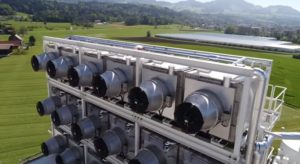The Reality of Negative Emissions
An article in The Economist makes a potent point: The sum of all carbon mitigation strategies worldwide will still not limit the rise in average global temperatures by 2 degrees above pre-industrial times. The article notes that 101 out of 116 climate change models assume that greenhouse gases will somehow be sucked out of the air… creating negative emissions. According to an Oxford University professor, “It is built into the assumptions of the Paris agreement.”

Agriculture will play a large role in lowering emissions
Scientists believe that two-thirds of the gap can be fulfilled with tree planting and changing agricultural practices, such as shallower tilling of soil. The remainder will have to be done with more expensive mitigation strategies, such as carbon capture and sequestration at power plants and algal conversion.
An MIT Technology Review article is both alarming and motivational: “Unless we start cutting carbon dioxide emissions soon, it’s going to cost today’s young people as much as $535 trillion to clean the atmosphere by 2100. If we start in earnest, reducing emissions by 6% per year by 2021, it will only cost $8 – 18.5 trillion to extract enough carbon dioxide to avoid the worst dangers of climate change.” Hmmm.
The world’s first facility to suck GHGs from thin air is near Zurich, Switzerland. The $23 million Climeworks project is the first commercial CO2 capture plant. Funded by Bill Gates and the European Space Agency, it now removes and captures emissions at a cost of $600/ton with a goal to drop this to $100/ton, and an ambition to capture 1% of global emissions by 2025. Other companies are also in the space: Carbon Engineering in Canada, Global Thermostat in the United States, and Skytree in The Netherlands. Then there are riskier geo-engineering such as dimming the world’s sunshine (a Harvard geo-engineering project) and dumping iron into the oceans to soak up carbon.

CO2 Capture Plant in Zurich (Climeworks YouTube)
In related news, “Drawdown” is a new book by Paul Hawken written in lay language that is an educational tool on cutting greenhouse gas emissions. Tor Allen of the Solar Schoolhaus, calls it “the most comprehensive plan ever proposed to reverse global warming.” In the book, Hawken and his “Drawdown Fellows” delineate and then calculate the impact of 80 global climate change solutions. Drawdown refers to the specific goal of lowering carbon dioxide concentrations in the atmosphere and bringing carbon back to Earth. Fully eight of the top 20 solutions are in the food sector, including “reducing food waste” and “eating a plant-rich diet.” Energy solutions are key, as are means to empower women through “educating girls (#6)” and “family planning (#7).”
